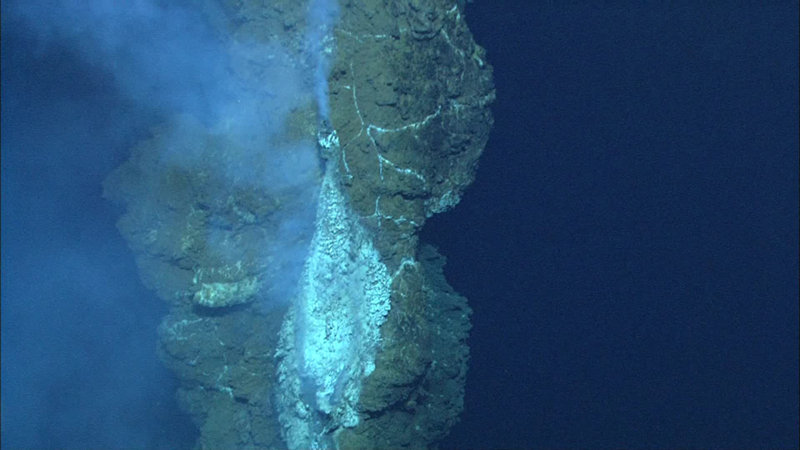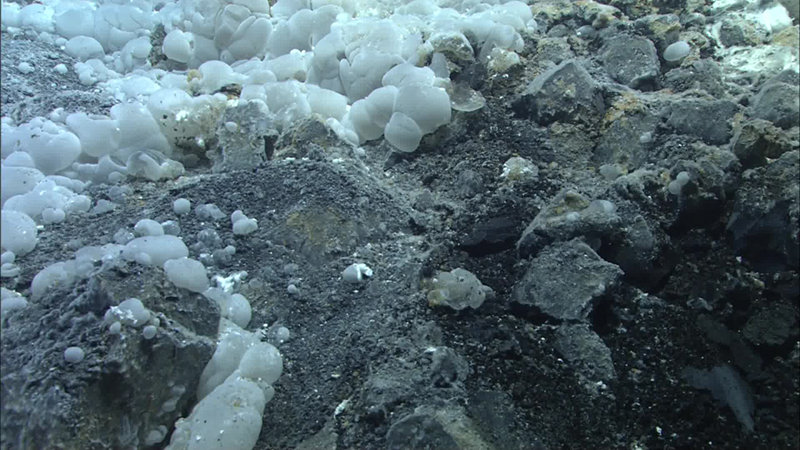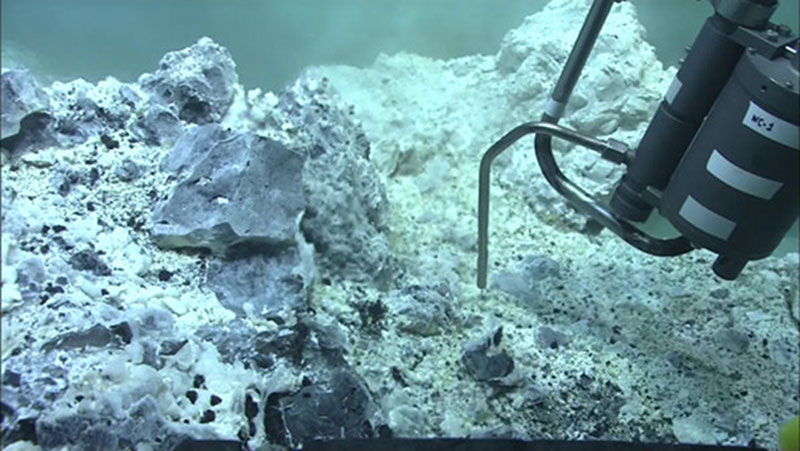
By David Butterfield, Joint Institute for the Study of the Atmosphere and Oceans - University of Washington and NOAA/PMEL
September 15, 2012
Part of our exploration mission is to find and sample previously unseen hydrothermal vents, and to put them in the context of known hydrothermal features. Volcano O is the most captivating feature on a map of the Northeast Lau Basin, sitting enigmatically between the volcanic arc and the backarc NE Lau spreading center. At 15 km across and nearly perfectly circular, it certainly catches the eye. Our dive at Volcano O focused on the central cone near the summit, which is interpreted to be the site of the most recent volcanism. The dive began on the western slopes of the cone at depth of approximately 1310 meters. There were signs of low-level hydrothermal output without visible shimmering (bluish-white filamentous mats and orange-gray mats with abundant scale worms and other small vent fauna). Some shrimp were also present, although they were not highly visible from a wide view and may not be apparent in the video.
As we ascended the cone, we encountered curiously abundant grayish blobs. This material was widespread, either concentrated and covering rock surfaces or scattered. It appeared to take on the color of the dominant hydrothermal staining, i.e. gray or bright white. There was also abundant white floc in the water column and dusting the seafloor. We have seen similar blobs before (identified as “mucopolysaccharride“) at Axial Seamount, another large caldera in the NE Pacific, following the 1998 and 2011 eruptions there. These observations would agree with the interpretation that the gel-like material is a microbial exudate, possibly a secretion from biofilm-forming communities living below the seafloor, which is gradually shed and flushed out of the sub-seafloor after eruptions, forming into hydrophobic clusters on the seafloor. It is notable that these features are visually very similar on Volcano O and Axial Seamount, even though the fluid chemistry is quite different.

A hot vent (255 degrees C) near the top of a 38-m-high sulfide chimney in the Loloa Kakai vent field on the Fonualei rift, sampled during dive Q233. The vent fluids forming these giant columnar chimneys are a result of water/rock reaction deep below the seafloor. They have a pH of approximately 5.2, not nearly as acidic as Volcano O cone fluids. Image courtesy of MARUM, University of Bremen and NOAA-Pacific Marine Environmental Laboratory. Download larger version (jpg, 370 KB).

These gelatinous globules covered large areas of the seafloor seen while the ROV was ascending the western slope of the central cone within the large caldera of Volcano O during dive Q324. Very similar globules have been seen at Axial Seamount on the Juan de Fuca ridge following a volcanic eruption. Image courtesy of MARUM, University of Bremen and NOAA-Pacific Marine Environmental Laboratory. Download larger version (jpg, 369 KB).
As this dive progressed, we moved up to the summit, where there was a shallow pit surrounding what is undoubtedly a volcanic vent. There were some signs of molten sulfur flows, e.g. thick yellow draped features over the edge of the crater rim, but we did not see extensive massive sulfur deposits. Evidently the latest stage of volcanic output was dominated by lava and volcaniclastic debris. There was a billowing plume of particulate sulfur emanating from the small pit, with somewhat variable output. The plume at times reached the ROV sitting on the edge of the pit, partially enveloping it and temporarily obscuring visibility. Magmatic gas is the source of the particulate sulfur clouds: when magmatic sulfur dioxide gas reacts with water, the products are elemental sulfur and sulfuric acid. If the temperature is above 115 degrees C, the elemental sulfur will be molten and usually bright yellow. At lower temperatures, sulfur is solid and may appear white or pale yellow. Clear, hot hydrothermal fluids were venting all around through the sands. Temperature measured 105 degrees C near our first fluid sampling site. Visually, this was exactly like the eruptive pit at NW Rota-1 in the Mariana arc, observed in the 2004 Submarine Ring of Fire Expedition (“Shimmering Sands“ vent). The Volcano O sample yielded a pH of 2.2 in the shipboard lab, and had approximately 600 micromol/L of dissolved sulfide. We expect there will be a strong magmatic sulfur gas signal of excess sulfate and dissolved sulfite when we measure these samples in the lab on shore.
One of the most striking features of the cone inside the Volcano O caldera was the vertical zonation of the hydrothermal venting and macrofauna. There were absolutely no animals visible within the smoky summit crater itself, nor around the rim of the crater, where there was extensive venting. We saw one dead pelagic shrimp which had apparently succumbed to the volcanic plume. Upon descending from the summit of the cone to a depth of approximately 1260 m, the active venting decreased markedly, and bright white or yellow staining was replaced by orange mat. In some places the dark volcanic rock was covered by a thick, quivering gelatinous orange mat. This iron-rich mat is a result of microbial colonization on rock surfaces where acidic fluids bring iron up to the seafloor. In this zone, there were abundant small polychaete worms and a few zoarcid fish (eelpouts), presumably preying upon the small polychaetes. Upon continued descent, the amount of mat decreased and transitioned to pale blue filamentous mat. Although not obvious at first, there were abundant hydrothermal shrimp in this zone. We captured several shrimp in the suction sampler, one of which had a length approximately one third of the diameter of the suction chamber. However, these wily shrimp were able to make their escape before the suction chamber could be sealed off. We took water samples from the shrimp habitat to characterize the ambient conditions where the most biota were seen. These waters were near neutral (pH 7.37), only slightly below normal ambient seawater.

Taking a sample of hot water with a titanium syringe sampler. The pH of the water here was approximately 2. No animals of any kind were seen in this environment, except for a hapless shrimp who succumbed to the toxic emissions. Image courtesy of MARUM, University of Bremen and NOAA-Pacific Marine Environmental Laboratory. Download image (jpg, 98 KB).
These observations, as well as some from previous expeditions, suggest that the strong acid and sulfur dioxide emitted by the volcanic vent and nearby hydrothermal vents are toxic to macrofauna. On this volcano, the animals avoid the toxic plumes by staying lower on the volcano where the weak emissions are neutralized by sub-seafloor dilution and water-rock reaction. This kind of avoidance is not seen around high-temperature black smoker vents, where the pH of the hot fluids is buffered by rock and is less acidic. Active volcanic vents on submarine arc volcanoes are strongly influenced by magmatic gases injected into the shallow sub-seafloor, and a slight change in redox chemistry of arc magmas (relative to basaltic mid-ocean ridge magmas) produces sulfur dioxide, a strong acid, rather than the weak acid hydrogen sulfide that dominates mid-ocean ridge spreading environments. We are hoping to find and sample more vents during this expedition to increase our knowledge of the diversity of hydrothermal chemistry and how it relates to the amazing ecology of submarine volcanoes.